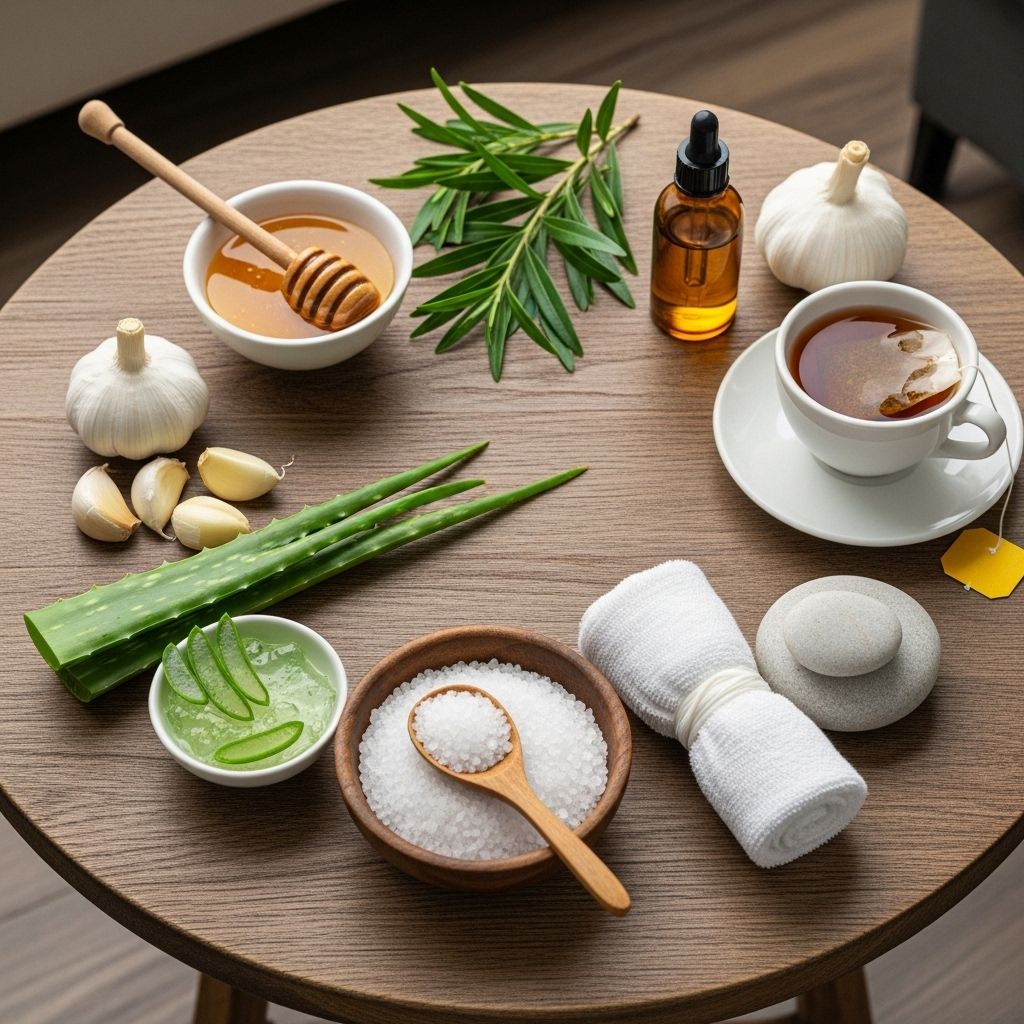Top Home Remedies and Prevention Tips for Cellulitis
Gentle care steps and simple routines can soothe irritation and bring back comfort.

Home Remedies for Cellulitis: A Comprehensive Guide
Cellulitis is a potentially serious bacterial skin infection characterized by redness, swelling, and pain, most commonly affecting the lower legs. Proper medical treatment is crucial, yet home care can play a supportive role in recovery and prevention. This article details the essential home remedies, expert-backed preventative measures, and frequently asked questions regarding cellulitis, mirroring the comprehensive structure of leading health resources.
What is Cellulitis?
Cellulitis arises when bacteria—typically Staphylococcus or Streptococcus species—enter the skin through cuts, abrasions, burns, insect bites, or other skin injuries. The infection can rapidly spread to deeper tissues and, in severe cases, enter the bloodstream, making timely medical intervention imperative.
Common symptoms include:
- Red, swollen, and warm skin
- Pain and tenderness in the affected area
- Fever and chills
- Red streaks extending from the area
Cellulitis can occur anywhere but usually targets the lower legs due to vulnerability to minor injuries.
Warning Signs and When to See a Doctor
Immediate medical attention is needed if cellulitis presents with any of the following:
- Fever higher than 100.4°F (38°C)
- Rapidly spreading redness or swelling
- Pus or drainage from wound
- Red streaks radiating from the infected area
- Loss of sensation, severe pain, or numbness
- Symptoms lasting more than two days without improvement
Attempting to treat cellulitis solely at home without antibiotics can result in dangerous complications. Consult a healthcare provider for any suspected cases.
Medical Treatment for Cellulitis
Antibiotics are the primary treatment for cellulitis and should be taken as prescribed for the entire course, even if symptoms improve within 48 hours. Discontinuing early risks recurrence or resistance.
For severe infections, intravenous antibiotics may be necessary.
Supportive Home Remedies During Recovery
While antibiotics combat the infection, several home care strategies can help manage symptoms and minimize complications during recovery. Always consult your physician before adding any remedies to your regimen.
- Covering the wound: Use sterile bandages as directed, changing them regularly to protect the skin and promote healing.
- Keeping the area clean: Clean affected skin gently per medical advice. Avoid harsh scrubbing or irritating soaps.
- Elevating the affected limb: If in the leg or arm, elevating above heart level reduces swelling and discomfort.
- Cool compresses: Apply a clean, cool, damp cloth to reduce heat and pain. Avoid direct ice packs which may aggravate damaged skin.
- Over-the-counter pain relief: NSAIDs such as ibuprofen or naproxen can help manage inflammation and discomfort.
- Treat underlying skin conditions: Address predisposing issues like eczema or athlete’s foot to prevent recurrent infections.
- Complete all antibiotics: Never stop early, even if symptoms subside.
Important Cautions
- Do not attempt to self-treat with herbal or alternative remedies alone.
- Avoid using chemical ice packs or unproven topical treatments that may irritate the skin.
- Monitor for worsening symptoms and seek help immediately if they occur.
Natural Remedies and Adjunct Care
Note: Natural/home remedies may provide comfort and support for mild symptoms but should never replace antibiotics for cellulitis. Always clear home treatments with a healthcare provider.
- Warm saline compress: May soothe pain and promote local circulation.
- Aloe vera gel: Known for soothing skin, anti-inflammatory properties (apply only to closed, unbroken skin).
- Coconut oil: Has mild antibacterial properties; may help moisturize and protect intact skin around the wound.
- Turmeric paste: Shown to be anti-inflammatory, but should only be used in consultation with a healthcare provider.
While these remedies can alleviate discomfort, they cannot eradicate the infection and should never delay conventional medical treatment.
How to Prevent Cellulitis Recurrence
Several lifestyle and self-care measures help lower the risk of future cellulitis outbreaks:
- Protect your skin: Wear long sleeves, gloves, and protective shoes/gardening boots when working outdoors or engaging in activities that risk abrasions.
- Treat minor wounds immediately: Clean with soap and water, apply antibiotic ointment, and cover with a sterile bandage. Seek medical care for deep puncture wounds, animal bites, or wounds near joints.
- Maintain skin hygiene: Regularly moisturize, especially after bathing, to prevent skin cracking and bacterial entry.
- Well-manicured nails: Keep nails short and smooth to avoid scratching the skin.
- Monitor high-risk areas daily: Especially feet in people with diabetes or reduced sensation, inspect for injuries or signs of infection.
- Treat underlying chronic conditions: Control diabetes, eczema, lymphedema and other skin/vascular issues, which raise cellulitis risk.
- Weight management: Achieving a healthy weight reduces risk of recurrent attacks.
- Stop smoking: Emerging research suggests smoking may increase cellulitis risk.
- Alcohol moderation: Limit intake; heavy drinking is associated with higher cellulitis rates.
For people with repeated bouts of cellulitis (three or more episodes per year), daily low-dose antibiotics may be recommended by a physician. If recurrences persist despite preventative care, consult a dermatologist for specialized advice.
Common Complications and Recovery Expectations
- How long does cellulitis last? Most cases resolve with antibiotics in one to two weeks. Mild cases may clear within days; severe or untreated infections can cause serious complications rapidly, even in healthy individuals.
- Potential complications:
- Abscess formation
- Bloodstream infection (sepsis)
- Deep tissue or organ involvement
- Recurrent infections, especially with underlying health conditions
Diet and Lifestyle Tips for Recovery
- Hydration: Drink plenty of fluids to support healing.
- Nourishing diet: Focus on high-protein, vitamin-rich foods that promote tissue repair (like lean meats, leafy greens, berries).
- Avoid excessive activity: Rest affected area as much as possible to lower swelling and pain.
- Follow up: Attend all scheduled medical visits, and report persistence, recurrence, or worsening symptoms immediately.
Quick Reference Table: Cellulitis Management
| Step | Description | Critical Notes |
|---|---|---|
| Seek Medical Care | Visit your healthcare provider for diagnosis and antibiotics | Do not attempt self-treatment for infection |
| Wound Care | Keep the area clean, covered, change dressings per instructions | Monitor for increased redness, drainage, pain |
| Symptom Relief | Elevate area, apply cool compress, take NSAIDs as needed | Cool compress aids swelling; NSAIDs relieve pain |
| Antibiotics | Complete full course as prescribed | Early discontinuation risks recurrence |
| Prevention | Protect skin, moisturize, address chronic conditions | Reduces future risk significantly |
| Healthy Lifestyle | Stay hydrated, eat well, limit alcohol, quit smoking | Boosts immune recovery and overall health |
Frequently Asked Questions (FAQs)
Q: Can cellulitis be treated entirely at home?
A: No. Cellulitis requires antibiotic treatment prescribed by a healthcare provider. Home remedies can help support recovery but cannot replace medical care. Rapidly worsening symptoms, fever, or signs of spreading infection need immediate attention.
Q: Is it safe to use herbal remedies like turmeric or tea tree oil?
A: While some natural remedies have anti-inflammatory properties, they should only be used with professional supervision on intact skin. They cannot cure cellulitis or replace prescribed antibiotics.
Q: How can I prevent cellulitis from coming back?
- Protect skin from injury
- Treat wounds and underlying conditions promptly
- Maintain good hygiene and moisture
- Monitor weight, limit alcohol, and avoid smoking
- Consider daily antibiotics if recurrences are frequent, as advised by your doctor
Q: How long does recovery take?
A: Typical recovery occurs within 7–14 days of antibiotic treatment. Some swelling or redness may persist for several weeks in severe cases.
Q: Can I exercise during cellulitis?
A: Rest is recommended for the affected area until significant improvement is seen. Gentle movement may be encouraged if the physician approves, especially for those with lymphedema to reduce swelling safely.
Q: Why do I keep getting cellulitis?
A: Frequently recurring cellulitis may be due to unmanaged chronic conditions (diabetes, eczema, lymphedema), ongoing skin injuries, or insufficient preventative measures. Work with your physician to identify triggers and appropriate prevention strategies.
Key Takeaways
- Never attempt to treat cellulitis only at home—antibiotic therapy is mandatory.
- Home remedies can enhance comfort and healing during recovery but must not replace medical advice.
- Prevention is crucial: Protect skin, treat wounds, address underlying health issues, and maintain healthy lifestyle choices.
- Consult your doctor if symptoms worsen, do not improve, or recur.
References
- https://www.healthline.com/health/cellulitis-home-treatment
- https://www.aad.org/public/diseases/a-z/cellulitis-self-care
- https://www.health.harvard.edu/a_to_z/cellulitis-a-to-z
- https://www.stylecraze.com/articles/home-remedies-for-cellulitis/
- https://jamanetwork.com/journals/jamadermatology/fullarticle/2771021
- https://www.stylecraze.com/articles/effective-home-remedies-for-skin-tightening/
- https://my.clevelandclinic.org/health/diseases/15071-cellulitis
- https://www.ncbi.nlm.nih.gov/books/NBK303996/
- https://myhealth.alberta.ca/Health/aftercareinformation/pages/conditions.aspx?hwid=uh2784
Read full bio of Sneha Tete












